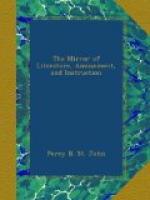“Fill higher the HIRLAS’
forgetting not those
Who shar’d its bright
draught in the days which are fled!
Tho’ cold on their mountains the
valiant repose,
Their lot shall be lovely—renown
to the dead!
While harps in the hall of the feast shall
be strung,
While regal ERYRI[3] with
snow shall be crown’d—
So long by the bard shall their battles
be sung,
And the heart of the hero
shall burn at the sound:
The free winds of Cambria shall swell
with their name,
And OWAIN’s rich HIRLAS be fill’d
to their fame!”
[3] Snowdon.
* * * * *
THE NATURALIST.
* * * * *
BIRDS OF LONDON.
It may be observed, that although many of the bird tribe seem to prefer the vicinity of the residence of man for their domicile, yet they, for the most part, avoid cities and large towns, for one, among other reasons, because there is no food for them. There are, notwithstanding, some remarkable exceptions to this. The House Sparrow is to be seen, I believe, in every part of London. There is a rookery in the Tower; and another was, till lately, in Carlton Palace Gardens; but the trees having been cut down to make room for the improvements going on there, the rooks removed in (1827,) to some trees behind the houses in New-street, Spring-gardens. There was also, for many years, a rookery on the trees in the churchyard of St. Dunstan’s in the East, a short distance from the Tower; the rooks for some years past deserted that spot, owing, it is believed, to the fire that occurred a few years ago at the old Custom House. But in 1827, they began again to build on those trees, which are not elm, but a species of plane. There was also, formerly, a rookery on some large elm trees in the College Garden behind the Ecclesiastical Court in Doctors’ Commons, a curious anecdote concerning which has been recorded.
The Stork, and some other of the tribe of waders, are occasionally also inhabitants of some of the continental towns.
Rooks appear to be peculiarly partial to building their nests in the vicinity of the residence of man. Of the numerous rookeries of which I have any recollection, most of them were a short distance from dwelling houses. In March, 1827, there was a rookery on some trees, neither very lofty nor very elegant, in the garden of the Royal Naval Asylum, at Greenwich; and although many very fine and lofty elms are in the park near, which one might naturally suppose the rooks would prefer, yet, such is the fact, there is not even one rook’s nest in Greenwich Park. Possibly the company of so large a number of boys, and the noise which they make, determine these birds in the choice of such a place for their procreating domicile.
There is also a remarkable fact related by Mr. French, on the authority of Dr. Spurgin, in the second volume of the Zoological Journal, which merits attention, in regard to the rook.




